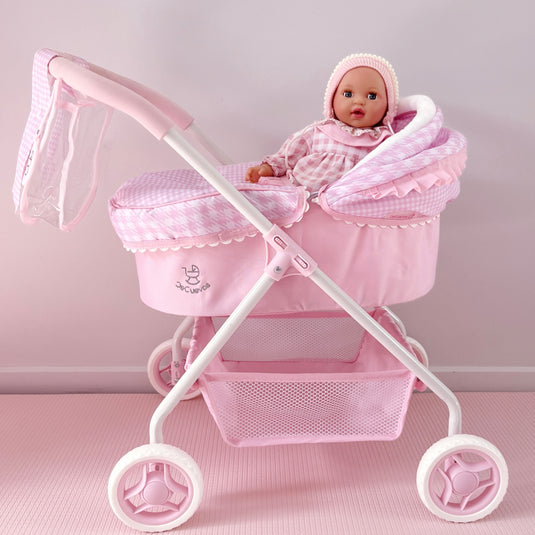The 8-Minute Rule for Dolls And Accessories
The 8-Minute Rule for Dolls And Accessories
Blog Article
8 Easy Facts About Dolls And Accessories Explained
Table of ContentsOur Dolls And Accessories PDFsNot known Facts About Dolls And AccessoriesThe Only Guide to Dolls And AccessoriesDolls And Accessories for Dummies10 Easy Facts About Dolls And Accessories ShownWhat Does Dolls And Accessories Do?Not known Details About Dolls And Accessories
When dolls are consisted of in team play, youngsters practice waiting, sharing, and listening to others' concepts. Whether they're pretending to be a moms and dad, brother or sister, or close friend, kids find out just how connections workhow to sustain others, address differences, and care for another person. These very early role-play experiences come to be the groundwork for healthy friendships and connections later on in life.Duplicating comforting regimens with a doll (feeding, shaking, placing to bed) can help youngsters really feel calm and protected. Taking treatment of a doll can make a kid feel capable and certain.
The Best Strategy To Use For Dolls And Accessories
When kids see dolls that mirror their race, heritage, and society, it enhances a positive sense of identification. It states, "You belong. Your tale matters." Dolls additionally present children to cultures outside their very own, constructing respectful interest and empathy for others. This is where inclusive play can cause inclusive neighborhoods.
As Dr. Karyn Purvis, a leader in kid development and trauma-informed care, once stated: This effective quote highlights exactly how play isn't just funit's how children discover ideal. The brain cords itself through repeating. When a youngster is engaged, cheerful, and psychologically attached to an activitylike doll playthe brain enhances those links faster and a lot more meaningfully.
The Single Strategy To Use For Dolls And Accessories

Boys require compassion, compassion, and creative imagination tooand doll play offers that. Yesdolls provide something unique. They motivate flexible storytelling and psychological link in such a way few various other toys do. Dolls are typically a kid's first "pal," assisting them exercise partnerships, develop communication skills, and feel comforted. Youngsters establish their feeling of self from a young age.
What Does Dolls And Accessories Do?
Through play. Through satisfaction. Via dolls that matter. Many thanks for joining us on this journey. Samantha Ong Samantha Ong is the creator of Joeydolls, a Canadian-based plaything brand on a mission to celebrate Eastern societies through joyful, comprehensive play. Motivated by her own experiences growing up without social representation, Samantha designs dolls that aid youngsters feel pleased with that they are while sparking inquisitiveness and compassion in others.
Playing with dolls urges kids to talk more about others' ideas and feelings, a research has found. The study recommends that playing fictional video games with dolls can aid kids develop social skills, concept of mind and compassion. The neuroscientist who led the work claimed that the educational worth of having fun with Lego and construction playthings was widely approved, but the benefits of playing with dolls often showed up to have actually been overlooked."When youngsters develop imaginary globes and function play with dolls, they communicate at initial out loud and afterwards internalise the message about others' ideas, emotions and feelings," claimed Dr Sarah Gerson, a neuroscientist at Cardiff University and the lead author.
How Dolls And Accessories can Save You Time, Stress, and Money.
They were additionally most likely to address the dolls in the second individual, speaking to them straight, whereas the personalities on the computer display they had a tendency to refer to in the third person. No distinction was observed between young boys and women."Inner state language can show that a child is considering other individuals's ideas and emotions while playing with dolls," claimed Gerson.
And that they see language use in this respect is excellent verification of the hypothesis."Mardell added that the searchings for ought to apply to any kind of kind of role-play plaything, instead than being particular to Barbies."Children normally begin to reveal indicators of interior state language around the age of four.
The Basic Principles Of Dolls And Accessories
"It becomes crucial for making and sustaining friendships, and exactly how they find out from their teachers, and moms and dads."The study also discovered that the youngsters had raised brain activity in the posterior superior temporal sulcus (pSTS) region when they spoke as though their dolls had thoughts and sensations. The pSTS region is believed to be included in the growth of social and emotional handling abilities.
Childhood is not a static life phase; without a doubt, the meaning, significance and understanding of childhood years are all based on modification. By the 19th century among one of the most extensive modifications was the relevance positioned on permitting children to experience "the care free pleasures" of youth with playtime my website activities. Play was now considered to be a critical element of a great youth.
In order to fully comprehend the meaning of play, one have to additionally understand the importance of the doll. However, dolls are a lot more than toys made to captivate young women. During the nineteenth century proper playtime activities were selected to advertise intellectual, physical or emotional growth. Dolls were especially prominent because they were believed to promote and nurture womanly qualities such as generosity, caring and empathy.
A Biased View of Dolls And Accessories

It is only through historical examinations that scientists can hope to reveal and record the complete variety of play experiences. Narrating these experiences, and specifically the function of dolls, is important for providing a much more complete photo of childhood throughout the 19th century. Alarcn, Sara E - doll accessories., "Child's Play: The Function of Dolls in 19th Century Childhood" (2007 )
Report this page